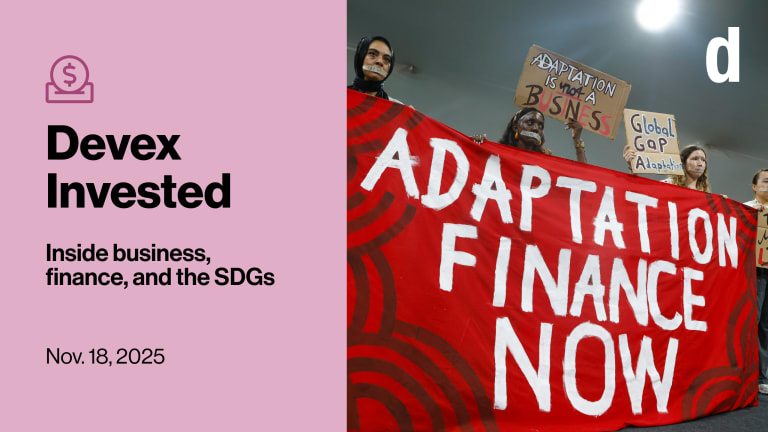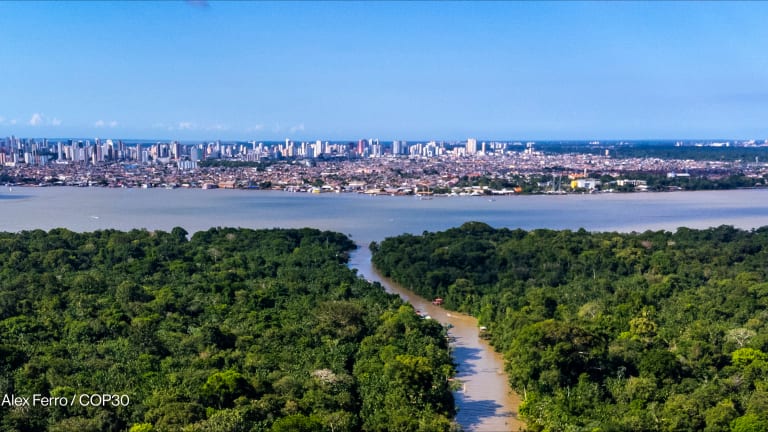New climate fund makes progress on a leader, but not on scale
The loss and damage fund's second board meeting saw consensus on the executive director's role description, but not on how ambitious the scale of the fund to address the impact of climate change should be.
The loss and damage fund was agreed to with much fanfare and controversy at the 27th U.N. Climate Change Conference. Now comes the hard part — making it a reality. A meeting in Songdo, South Korea, last week was a crucial step in the process, as the board of the newly named Fund for Responding to Loss and Damage hammered out key technical details to bring the fund to fruition, including the specifications for its director’s position. The fund came into being in 2022 after a sustained push by lower-income countries to help them financially cope with the loss and damage caused by the impacts of climate change, from heat waves and floods to drought and desertification. “The urgency of having the fund is quite critical. Loss and damage is a very serious issue for least developed countries,” Adão Soares Barbosa, a board member and the LDC representative, said at the close of the meeting, pointing out how Caribbean communities had just been hit by Hurricane Beryl. What’s in a name? During the meeting held from July 9 to 12, the board, made up of 12 members from developed countries and 14 from developing countries, chose the formal name of the fund. The name Fund for Responding to Loss and Damage pleased developing countries due to the explicit mention of the concept of loss and damage, considering the historical resistance of some developed countries to do so. “It was basically the United States that objected to having loss and damage in the name,” Brandon Wu, director of Policy and Campaigns at ActionAid USA, told Devex. “One country imposing a name or objecting to a very common sense name because of their own kind of domestic political concerns doesn’t feel appropriate for a multilateral fund.” A host country The Philippines was selected as host country of the board. While this does not mean that the Philippines will be the mandatory venue for future board meetings, or that the country will have an oversized role in managing the fund, it is a necessary role that gives legal personality to the board. With the selection of the Philippines as host country, the board can now formally negotiate with the World Bank, which — as approved last June — will be the trustee of the fund for an interim period of four years. “Why is this needed? Because if tomorrow the board has to fire the World Bank and get another trustee, the control will remain with the board through that legal host country,” Harjeet Singh, global engagement director of the Fossil Fuel Non-Proliferation Treaty Initiative, explained. “We would like to attract a candidate who has the capacity to raise billions, who can speak to those institutions and rich countries’ governments and say ‘We want billions.’” --— Harjeet Singh, global engagement director, Fossil Fuel Non-Proliferation Treaty Initiative Who will be in charge? During the meeting, the board agreed on the job description for an executive director and the selection process, which will start with a search agency contracted by the World Bank gathering a list of potential candidates. “That person is going to have a lot of power in terms of how the fund really operates and what kind of things the fund prioritizes. We need somebody in that position who isn’t just a banker,” Wu said. “We need somebody who really understands climate change, understands loss and damage, understands the needs of developing countries. We need somebody with real world experience.” The board will choose the best candidate among three preselected. As the person will be a World Bank employee, the institution has veto power over the final choice. For civil society, “the key is to have transparency on how the different candidates measure against the different conditions that are set and on how the selection is made,” Lien Vandamme, senior campaigner at the Center for International Environmental Law, said. Millions to billions? Negotiations on the executive director role were not straightforward. Board member Mohamed Nasr, representative of African states, highlighted the need to specify the economic scale of the fund in the recruitment process. His argument was that running a $100 million fund is completely different from a $10 billion fund. “We are giving an indication to these potential candidates that the scale of this fund is not confined to where it is. It is going to scale to a billion plus,” he said at the meeting, asking for this to be reflected in the job description text as “resource mobilization strategy that aims at reaching the billions.” “We would like to attract a candidate who has the capacity to raise billions, who can speak to those institutions and rich countries’ governments and say ‘We want billions,’” Singh said. “Scale — it’s an important aspect. Scale determines the kind of candidate you would attract,” he added. Yet the final text cites that the “Executive Director will be responsible for supporting the Board in growing the Fund from its level at the time of the appointment” — with no mention of billions. “We can clearly see that rich countries are trying to avoid the conversation on billions because they want this fund to be just as couple of hundred million,” Singh explained, adding: “They have to realize the fact that damages are happening in hundreds of billions of dollars, and we have to talk about billions now.” Raising more funds “The biggest challenge right now is getting money into the fund,” Wu said. “We can talk about the technical stuff all day but, ultimately, if there is no money, then it does not mean much.” The pledges made to date to the fund come to a total of $661.39 million. In this second meeting, only South Korea announced an additional contribution of $7 million, taking the total to $668.39 million. “The long-term resource mobilization strategy should reflect the needs of communities and countries, and not a number that rich countries feel comfortable to mobilize,” Singh argued. With lack of progress on agreeing on, or even mentioning the scale needed for the fund, the board decided the operationalization of the resource-mobilization strategy would be finalized by the end of 2025. Until then, besides pledging more money to the fund, Singh considers it is important to receive the money that has been pledged so far. “We need to secure the money this year, so that there is no reversal of that decision by new governments after elections,” he said. The big question: When will the funds be available? The quick answer is in mid-2025. The long answer is that to get there, key decisions need to be made to answer questions such as what the role of the World Bank as a trustee will be, what sort of team needs to be hired to manage the funds, how the money will be channeled, and what environmental and social safeguards are needed to ensure the funds go to the right places. “None of these are simple questions and all of them have to be negotiated by the Board, which is not like a corporate board. It’s a democratic negotiation body where you have half developed countries and half developing ones, both groups with very different interests in this process,” Wu said. More than 350 organizations signed a petition asking the board to set up a special mechanism or “window” that could ensure local communities a more direct access to the resources. Vandamme told Devex that civil society is working on this proposal in order to see some progress in the conversations at the next meeting of the board. What’s next The third board meeting will be in mid-September in Baku, Azerbaijan, the host of the 29th U.N. climate summit, where the board is expected to announce the executive director, among other procedural aspects. One of the main issues that countries will have to decide on at COP 29 is the new collective quantified goal on climate finance, or NCQG. This is likely to have an impact on the amount that is pledged to the loss and damage fund. “It is connected, implicitly,” Singh said, explaining that rich countries pushed the deadline to finalize the resource mobilization strategy to next year because the NCQG conversations are happening at COP 29. Both negotiations imply financial contributions from the developed world. The question is whether developed countries will agree to be ambitious with high amounts of money on both issues. Observers are concerned that if the NCQG results in an ambitious figure at COP 29, next year developed countries may not want to pledge billions to the loss and damage fund. Wu sees the media attention on COP 29 as an opportunity to push for more climate financial resources. “It would be a great moment for developed countries to come forward with meaningful pledges in billions of dollars for the fund. That would do a lot to build trust, not only for the success of the loss and damage fund, but for the success of the broader U.N. climate negotiations as well.”
The loss and damage fund was agreed to with much fanfare and controversy at the 27th U.N. Climate Change Conference. Now comes the hard part — making it a reality.
A meeting in Songdo, South Korea, last week was a crucial step in the process, as the board of the newly named Fund for Responding to Loss and Damage hammered out key technical details to bring the fund to fruition, including the specifications for its director’s position.
The fund came into being in 2022 after a sustained push by lower-income countries to help them financially cope with the loss and damage caused by the impacts of climate change, from heat waves and floods to drought and desertification.
This story is forDevex Promembers
Unlock this story now with a 15-day free trial of Devex Pro.
With a Devex Pro subscription you'll get access to deeper analysis and exclusive insights from our reporters and analysts.
Start my free trialRequest a group subscription Printing articles to share with others is a breach of our terms and conditions and copyright policy. Please use the sharing options on the left side of the article. Devex Pro members may share up to 10 articles per month using the Pro share tool ( ).
Tais Gadea Lara is a climate journalist from Argentina. She has been covering the climate negotiations and international politics since 2014. She is currently a climate explorer at the Constructive Institute. She is the author of the newsletter Planeta and collaborates in different media, such as the National Geographic, Climática La Marea, and Climate Tracker. In 2020, she created the Environmental Journalism Workshop to train more people in the communication of the climate and ecological crisis. For several years, she has been recognized as one of the 100 Latinos most committed to climate action.








